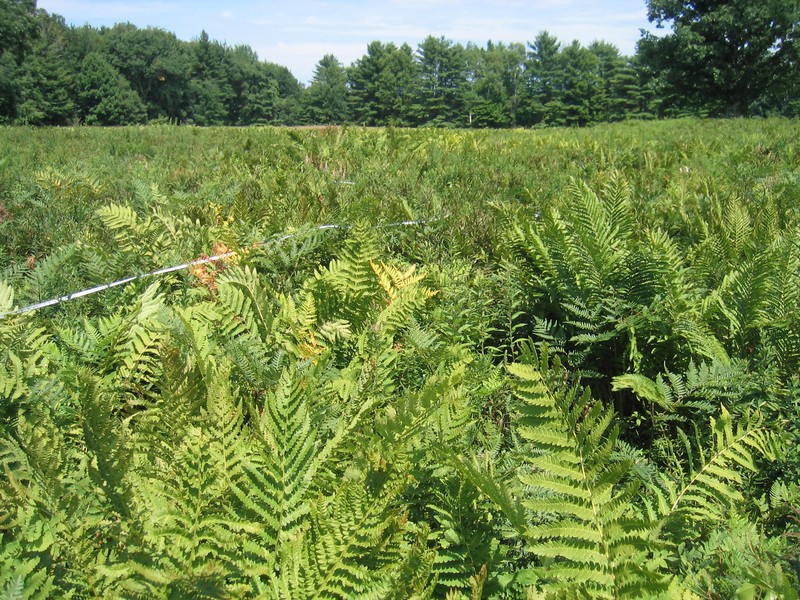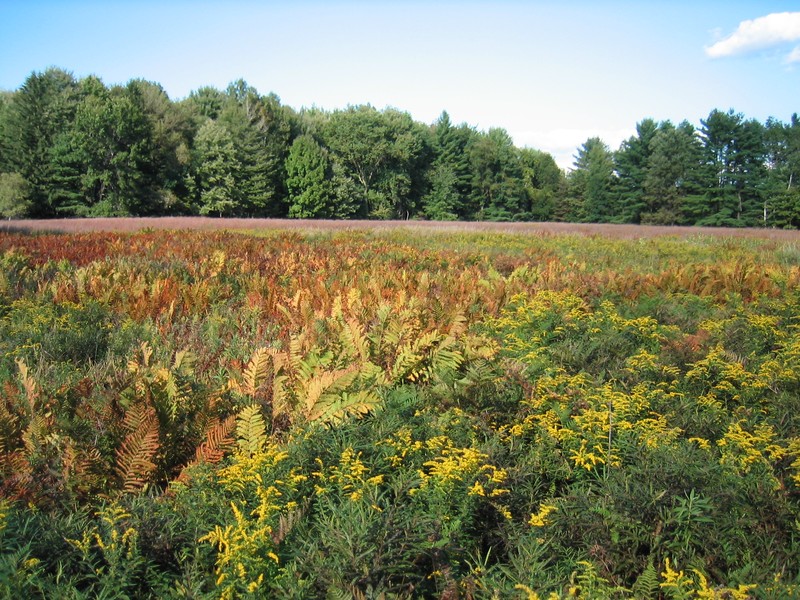Successional Fern Meadow
- System
- Terrestrial
- Subsystem
- Open Uplands
- State Protection
- Not Listed
Not listed or protected by New York State.
- Federal Protection
- Not Listed
- State Conservation Status Rank
- S3S4
Vulnerable in New York, or Apparently Secure - Vulnerable to disappearing from New York (but not currently imperiled), with relatively few populations or locations, few individuals, and/or restricted range; or uncommon but not rare in New York; may be rare in some parts of the state; possibly some cause for long-term concern due to declines or other factors. More information is needed to assign either S3 or S4.
- Global Conservation Status Rank
- G4
Apparently Secure globally - Uncommon in the world but not rare; usually widespread, but may be rare in some parts of its range; possibly some cause for long-term concern due to declines or other factors.
Summary
Did you know?
Fern meadows are typically dominated by bracken fern (Pteridium aquilinum var. latiusculum), but up to nine species of fern have been recorded in one 100 square meter plot sampled in this community. In addition to bracken fern, the following ferns may be present: cinnamon fern (Osmundastrum cinnamomeum var. cinnamomeum), sensitive fern (Onoclea sensibilis), marsh fern (Thelypteris palustris var. pubescens), royal fern (Osmunda regalis var. spectabilis), lady fern (Athyrium angustum), hay-scented fern (Dennstaedtia punctilobula), interrupted fern (Osmunda claytoniana), and New York fern (Thelypteris noveboracensis).
State Ranking Justification
This community is widespread throughout upstate New York, north of the North Atlantic Coast Ecoregion, but somewhat restricted to sites where the substrate is moist sand and kept open through prescribed burning or infrequent mowing. There are an estimated 100 to 3,000 extant occurrences statewide and there are only a few good quality examples in New York. Successional fern meadows are threatened by fire suppression, invasive species, and fragmenting development.
Short-term Trends
The number and acreage of successional fern meadows in New York have probably declined slightly in recent decades due to fire suppression, disturbance by off-road vehicles, trash dumping, and development.
Long-term Trends
The number and acreage of successional fern meadows in New York have probably had very large declines from historical numbers due to fire suppression, fragmentation, disturbance by off-road vehicles, trash dumping, and development.
Conservation and Management
Conservation Overview
Develop and implement prescribed burn plans at appropriate sites. Reduce or minimize fragmenting features, such as residential and commercial development, roads, abandoned clearings, unnecessary trails, etc. Restrict mountain bikes and ATVs to designated trails and least sensitive areas, and prevent dumping of trash. Remove or control invasive species where appropriate.
Threats
The primary threat to successional fern meadows is the lack of disturbance to maintain the community (such as fire or mowing). Lack of fire will likely result in the invasion of woody species from the surrounding woodlands that may convert the fern meadow to shrublands and eventually to successional hardwoods. Other threats to this community include local fragmentation (e.g., bisecting roads and trails) or conversion to successional old field or mowed lawn. Lastly, successional fern meadows are threatened by invasive species, such as spotted knapweed (Centaurea stoebe. ssp. micranthos).
Conservation Strategies and Management Practices
Develop and implement prescribed burn plans at appropriate sites. Reduce or minimize fragmenting features, such as residential and commercial development, roads, abandoned clearings, unnecessary trails, etc. Restrict mountain bikes and ATVs to designated trails and least sensitive areas, and prevent dumping of trash. Remove or control invasive species where appropriate.
Development and Mitigation Considerations
Development should avoid fragmentation of such systems to allow for nutrient flow, seed dispersal, and seasonal animal migrations within them. Bisecting trails, roads, and developments can also allow exotic plant and animal species to invade.
Inventory Needs
Survey for occurrences statewide to advance documentation and classification of successional fern meadow. Continue searching for large sites in good condition (A- to AB-ranked).
Research Needs
Determine the optimal fire regime for this community.
Rare Species
Range
New York State Distribution
This community is widespread throughout upstate New York, north of the North Atlantic Coast Ecoregion, but somewhat restricted to sites where the substrate is moist sand and kept open through prescribed burning or infrequent mowing.
Global Distribution
This somewhat broadly-defined community may be worldwide. Examples with the greatest biotic affinities to New York occurrences are suspected to span north to southern Canada, west to Minnesota, southwest to Indiana and Tennessee, southeast to Georgia, and northeast to Nova Scotia.
Best Places to See
- Saratoga National Historic Site (Saratoga County)
Identification Comments
General Description
This community is a dwarf or short shrubland (<0.5-1 m) overtopped by several species of ferns with bracken fern (Pteridium aquilinum var. latiusculum) typically dominant. Successional fern meadows occur on sites that have been cleared (for logging, farming, etc.) or otherwise opened by disturbance (e.g., fire). The shrub layer has <50% cover and is dominated by heaths, such as several blueberries (Vaccinium spp.).
Characters Most Useful for Identification
The shrub layer has <50% cover and is dominated by heaths, such as several blueberries (Vaccinium spp.). The herb layer has >50% percent cover and dominated by ferns. Fern meadows are typically dominated by bracken fern (Pteridium aquilinum var. latiusculum), but up to nine species of fern have been recorded in one 100 square meter plot sampled in this community. In addition to bracken fern, the following ferns may be present: cinnamon fern (Osmundastrum cinnamomeum var. cinnamomeum), sensitive fern (Onoclea sensibilis), marsh fern (Thelypteris palustris var. pubescens), royal fern (Osmunda regalis var. spectabilis), lady fern (Athyrium angustum), hay-scented fern (Dennstaedtia punctilobula), interrupted fern (Osmunda claytoniana), and New York fern (Thelypteris noveboracensis).
Elevation Range
Known examples of this community have been found at elevations between 220 feet and 1,740 feet.
Best Time to See
Although the ferns are identifiable through the summer, it is impressive to see the successional fern meadow in the early fall when the colors start to change.
Successional Fern Meadow Images
Classification
International Vegetation Classification Associations
This New York natural community encompasses all or part of the concept of the following International Vegetation Classification (IVC) natural community associations. These are often described at finer resolution than New York's natural communities. The IVC is developed and maintained by NatureServe.
- Western Brackenfern - Arctic Brome Grassland (CEGL005142)
NatureServe Ecological Systems
This New York natural community falls into the following ecological system(s). Ecological systems are often described at a coarser resolution than New York's natural communities and tend to represent clusters of associations found in similar environments. The ecological systems project is developed and maintained by NatureServe.
- Laurentian Pine-Oak Barrens (CES201.718)
Characteristic Species
-
Shrubs < 2m
- Comptonia peregrina (sweet-fern)
- Lyonia ligustrina var. ligustrina (maleberry)
- Rosa palustris (swamp rose)
- Rubus allegheniensis (common blackberry)
- Rubus hispidus (swamp dewberry)
- Spiraea alba var. latifolia (broad-leaved meadow-sweet)
- Spiraea tomentosa (steeplebush)
- Vaccinium angustifolium (common lowbush blueberry)
- Vaccinium corymbosum (highbush blueberry)
- Vaccinium myrtilloides (velvet-leaved blueberry)
- Vaccinium pallidum (hillside blueberry)
-
Tree seedlings
- Acer rubrum var. rubrum (common red maple)
- Betula populifolia (gray birch)
- Fraxinus americana (white ash)
- Populus tremuloides (trembling aspen, quaking aspen)
- Prunus pensylvanica (pin cherry, fire cherry)
- Sassafras albidum (sassafras)
-
Herbs
- Asclepias syriaca (common milkweed)
- Athyrium angustum (northern lady fern)
- Avenella flexuosa (common hair grass)
- Carex scabrata (rough sedge)
- Dennstaedtia punctilobula (hay-scented fern)
- Dichanthelium clandestinum (deer-tongue rosette grass)
- Euthamia graminifolia (common flat-topped-goldenrod)
- Geranium maculatum (wild geranium)
- Lycopus uniflorus (northern bugleweed, northern water-horehound)
- Lysimachia quadrifolia (whorled-loosestrife)
- Lysimachia terrestris (swamp-candles)
- Onoclea sensibilis (sensitive fern)
- Osmunda claytoniana (interrupted fern)
- Osmunda regalis var. spectabilis (royal fern)
- Osmundastrum cinnamomeum var. cinnamomeum (cinnamon fern)
- Patis racemosa (black-fruited rice grass)
- Pteridium aquilinum ssp. latiusculum (eastern bracken fern)
- Schizachyrium scoparium var. scoparium (little bluestem)
- Scirpus cyperinus (common wool-grass)
- Solidago rugosa var. rugosa (common wrinkle-leaved goldenrod)
- Thelypteris noveboracensis (New York fern)
- Thelypteris palustris var. pubescens (marsh fern)
- Verbena hastata (blue vervain)
-
Nonvascular plants
- Ceratodon purpureus
- Cladonia rangiferina
- Polytrichum commune
- Polytrichum juniperinum
Similar Ecological Communities
- Successional blueberry heath
Successional blueberry heath shrubs, such as blueberries (Vaccinium spp.), have greater than 50% cover, whereas successional fern meadows are dominated by ferns, and heath shrubs have less than 50% cover.
- Successional northern sandplain grassland
(guide)
Successional northern sandplain grasslands are dominated by grasses and sedges, such as little bluestem (Schizachyrium scoparium), hairgrass (Avenella flexuosa), and Pennsylvania sedge (Carex pensylvanica), whereas successional fern meadows are dominated by ferns, such as bracken fern (Pteridium aquilinum var. latiusculum). Grasses may be present in fern meadows, but they are only a minor component.
- Successional old field
Successional old fields are meadows dominated by forbs and grasses lacking heath shrubs that occur on sites that have been cleared and plowed (for farming or development), and then abandoned. They are dominated by goldenrods (Solidago spp.), and various pasture grasses, such as bluegrasses (Poa spp.), timothy (Phleum pratense), quackgrass (Elymus repens), smooth brome (Bromus inermis), sweet vernal grass (Anthoxanthum odoratum), orchard grass (Dactylis glomerata). Successional fern meadows have a dwarf or short shrub layer (<0.5-1 m and <50% cover) overtopped by several species of ferns with bracken fern (Pteridium aquilinum var. latiusculum) typically dominant.
- Successional shrubland
Successional fern meadows have a dwarf or short shrub layer (<0.5-1 m and <50% cover) overtopped by several species of ferns with bracken fern (Pteridium aquilinum var. latiusculum) typically dominant. Successional shrublands have at least 50% cover of short and tall shrubs, with heath shrubs usually absent or only a minor component.
Vegetation
Percent cover
This figure helps visualize the structure and "look" or "feel" of a typical Successional Fern Meadow. Each bar represents the amount of "coverage" for all the species growing at that height. Because layers overlap (shrubs may grow under trees, for example), the shaded regions can add up to more than 100%.
Additional Resources
References
Edinger, G. J., A. L. Feldmann, T. G. Howard, J. J. Schmid, F. C. Sechler, E. Eastman, E. Largay, L. A. Sneddon, C. Lea, and J. Von Loh. 2014. Vegetation inventory: Saratoga National Historical Park, New York. Natural Resource Technical Report NPS/NETN/NRTR—2014/869, National Park Service, Fort Collins, Colorado.
Edinger, G. J., D. J. Evans, S. Gebauer, T. G. Howard, D. M. Hunt, and A. M. Olivero (editors). 2014. Ecological Communities of New York State. Second Edition. A revised and expanded edition of Carol Reschke’s Ecological Communities of New York State. New York Natural Heritage Program, New York State Department of Environmental Conservation, Albany, NY. https://www.nynhp.org/ecological-communities/
New York Natural Heritage Program. 2024. New York Natural Heritage Program Databases. Albany, NY.
Links
About This Guide
This guide was authored by: Gregory J. Edinger
Information for this guide was last updated on: November 13, 2023
Please cite this page as:
New York Natural Heritage Program. 2024.
Online Conservation Guide for
Successional fern meadow.
Available from: https://guides.nynhp.org/successional-fern-meadow/.
Accessed July 26, 2024.


